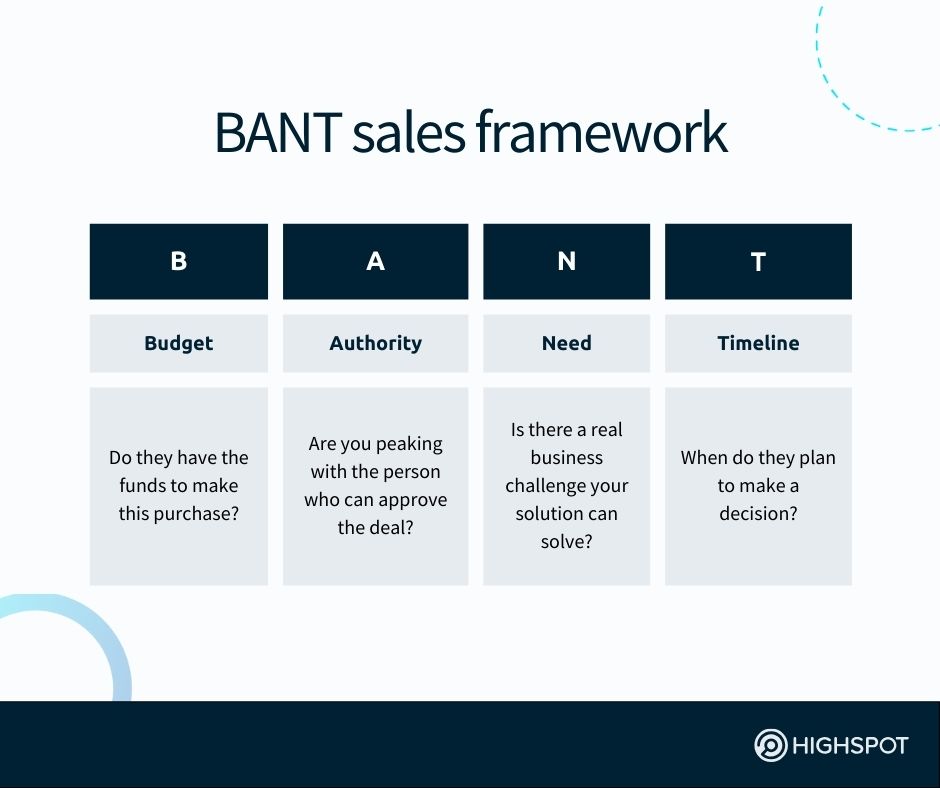Key Takeaways
- The BANT (Budget, Authority, Need, Timeline) methodology is a proven, flexible sales qualification framework for B2B go-to-market teams that works across industries and deal sizes.
- Asking qualified leads strategic, open-ended sales questions uncovers their budget realities, unearths key decision-makers, and identifies prospects’ urgency—all without sounding scripted.
- Combining the BANT approach with your GTM tech stack—notably, your sales enablement software and CRM—empowers your reps to better pitch to prospects and pivot as needed.
You’re on a discovery call. Your prospect seems curious. They ask questions about your products and services and how your offerings compare to competitors.
But how can you tell if they’re actually ready to buy—and in a position to make purchasing decisions today—or if they’re just ‘window shopping’ (that is, conducting due diligence on tools they may get way down the line)?
That’s where the BANT sales methodology shines for B2B sellers like yours. It allows you to quickly assess how real the opportunity is and avoid dead-end leads.
When used well, the BANT framework can effectively guide conversations with leads.
This means your sales reps can uncover what matters most to them, tailor their pitches to prospects’ pain points and priorities, and keep deal discussions moving full-steam ahead.
The result? Shorter sales cycles—and a much better shot of closing deals.
What is the BANT sales methodology?
The BANT framework is a classic sales qualification method used to determine a prospect’s fit and readiness to buy. It stands for Budget, Authority, Need, and Timing—the four key elements that help sales teams prioritise and tailor their approach.
By qualifying prospects through BANT, B2B sales representatives can focus their time on deals most likely to convert and align solutions to real buying drivers.
In a customer relationship management context, the BANT sales methodology is used to track whether a given lead has the financial capacity, decision-making power, business need, and purchase timeframe to qualify as a legitimate sales opportunity.

Why so many sales reps rely on BANT to qualify leads
Even with newer frameworks available, BANT remains a favourite because it fits into everyday sales conversations. No script required. Sales reps can use it in quick discovery calls or longer meetings, and it scales from small deals to enterprise opportunities.
- It speeds up lead qualification by quickly confirming the team’s budget and readiness so sales professionals can dedicate their time to high-probability deals.
- It shortens sales cycles by clarifying urgency, such as contract expirations, leading to faster closes.
- It leads to more useful conversations by tailoring solutions to real problems that engage the prospect, rather than just surface-level needs.
- It improves forecast accuracy by confirming budget, authority, and urgency for fact-based projections.
- It builds focus and confidence at every call by giving sales reps a clear path for what to listen for and ask next. That makes every discovery call more productive.
And when paired with an AI-powered sales training platform, BANT becomes even easier to apply, and its impact on sales efficiency shows up in real conversations.
How to use the BANT sales framework
Think of BANT as a conversation guide, not a rigid script.
According to a Bain & Company survey, 70% of companies struggle to integrate their sales plays into CRM systems, weakening qualification rigour and slowing growth.
Using BANT helps bridge this gap by prompting the right questions, qualifying leads early, and keeping your pipeline full of high-quality opportunities.
More to the point, employing the BANT framework helps your sales team:
1. Understand a prospect’s budget and expected value
Instead of jumping in with, “Do you have a budget?,” find out how your prospect defines value and what kind of investment they expect to make.
If ROI expectations far exceed their budget range, or the budget is unworkable, it may be time to disqualify. For example, if a prospect says they want to cut onboarding time in half within three months, but can’t afford your entry-level package costs, the gap may be too wide to close.
When that happens, don’t force a fit by jumping into a sales pitch. Instead, thank them, share a relevant resource or content, and move on.
2. Identify the key decision-makers and stakeholders
Knowing who the decision-makers are is just the start. You need to understand their role, priorities, and what a “yes” looks like for them.
It’s also important to identify internal champions early—they can advocate for your solution, smooth over objections, and keep the process moving.
Mapping the buying committee upfront helps you address the right needs at the right time.
“B2B buying groups are more diverse than ever, ranging from five to 16 people across as many as four functions,” Gartner Principal, Research Delainey Kirkwood said, referencing a 2025 Gartner sales survey. “Each member may have differing priorities and opinions.”
3. Get clarity on the level of a B2B buyer’s urgency
Figure out what’s sparking the conversation right now. Maybe a contract is about to expire, a competitor is making moves, or leadership is pushing for results by a certain date.
From there, you’ll be able to tell whether the deal has momentum or if it’s likely to drift. And if there’s no pressing reason to act, you’ll know to adjust your expectations and focus your energy elsewhere.
4. Build a realistic purchase and implementation timeline
Once you know why they’re acting, it’s time to pin down when. A realistic timeline helps you plan your follow-ups, align resources, and set expectations on both sides.
Map out the key milestones—internal approvals, budget sign-offs, vendor evaluations—so you can see the path to a decision. This ensures everyone’s on the same page and avoids last-minute surprises that could push the deal off track.
5. Stay ahead of potential delays or likely objections
Too many reps treat BANT like a box-ticking exercise during the discovery call, then never revisit throughout the sales process. The problem is, deals rarely follow a straight line.
Budgets shift. Priorities change. Decision-makers come and go. If you only capture BANT once and file it away, you risk making decisions based on outdated or incomplete information.
Use social listening and news alerts to track leadership changes, product or service launches, and funding news to anticipate new needs or roadblocks. Adjust your approach to stay relevant.
6. Learn how to master the art of tone and timing
Even the best BANT question can flop if it’s asked too soon or with the wrong tone.
As Eric Dates, contributor writer at MarTech, points out, most buyers are not persuaded by feature lists. Instead, they form a belief when they can connect what you’re offering to a believable “So what?” that reduces risk and feels worth the switch.
That’s why tone and timing matter. That means listening carefully, pausing when needed, and easing into more sensitive topics like budget or authority.
Sales coaching is one of the fastest ways to sharpen these skills.
As Eric Andrews, VP of Growth Marketing at TriNet, shared on Highspot’s Win Win podcast, “Real-time coaching … is going to be incredibly helpful in helping sellers in the moment, be able to course-correct… and optimise the time they’re spending with a prospect.”
You don’t have to rely solely on live coaching sessions, though.
One way to partially put it on autopilot is to leverage a unified sales enablement platform like Highspot, which offers native AI sales coaching functionality to help reps refine their pace, tone, and objection-handling in calls with role play.
This makes it easier to embed the BANT framework into onboarding, monitor how it’s used, and give targeted feedback that hones delivery over time.
Examples of BANT sales questions
These BANT sales questions qualify leads quickly by finding budget, decision-makers, needs, and timelines. Here’s a category-by-category list you can use right away during discovery calls:
Budget
These questions help you get a feel for what kind of investment your prospect is comfortable making without jumping straight into pricing.
- “Do you already have a budget set aside for this?”
- “What is the investment looking like for this project?”
- “Have you bought something like this before? What was the cost?”
- “How do you budget for tools like this?”
- “What would be a successful ROI for you six months from now?”
Authority
These questions help uncover who’s involved in the decision process without putting your prospect on the spot.
- “Who else should be in this conversation so we can move forward?”
- “How are decisions made at your company?”
- “What’s the approval process for new tools or vendors?”
- “Is there an internal champion for this?”
- “Once we find a good fit, what’s the sign-off process?”
Need
This is where you uncover your prospect’s pain points and goals. Think of it as your chance to be curious, not pushy.
- “What’s the biggest challenge you’re facing right now?”
- “What prompted you to start looking for a solution?”
- “How is this impacting your team or business goals?”
- “Have you tried to solve this before? What worked or didn’t?”
- “If we could remove this for you, what would that mean for your day-to-day and what could you gain in efficiency, revenue, and employee satisfaction?”
Timeline
Good timing-based questions help you plan the next steps and spot any red flags early.
- “Is there a specific date or deadline?”
- “When would you like to have a solution in place?”
- “What’s your buying process like in terms of timeline?”
- “Are there any upcoming events or changes that could impact your timeline?”
- “If we move forward next week, what needs to happen on your end?”
Limitations of BANT for lead qualification
The BANT sales process works best early in the sales cycle, but it assumes buyers have answers ready, which isn’t always the case, especially if they’re still exploring multiple solutions. It can feel transactional if applied rigidly, with questions like, “Do you have budget?,” coming across as aggressive.
It can also overlook emotional or internal drivers that influence decisions, such as internal pressure to change or dissatisfaction with a current vendor. These gaps become more apparent in high-stakes or long sales cycle deals, where sales reps need a deeper understanding to qualify.
Alternatives to the BANT framework
The BANT framework is not the only sales qualification methodology worth knowing.
“There’s no shortage of available methodologies,” Highspot’s A Measured Approach to Sales Methodologies Guide explains. “The abundance of options can make choosing just one feel like an impossible task, especially because not just any will do: Some were built with specific sales cycles or processes in mind, while others aim to account for differences in product types and buyer experiences.”
If your deals are more complex or high-value, one of these other sales methodologies may be a better fit or BANT complement.
- MEDDIC: This methodology is designed for enterprise deals with multiple stakeholders. It focuses on metrics, decision criteria, and the buying process, making it ideal for navigating complex, multi-layered sales.
- CHAMP: This one flips BANT and starts with the prospect’s challenge, not budget. This makes it more consultative and helpful in identifying pain and urgency, or addressing these early in the conversation.
- SPIN selling: This approach is great for relationship building. It uses Situation, Problem, Implication, and Need-Payoff questions to guide discovery. It’s useful when connecting the dots between problems and outcomes.
- GPCTBA/C&I: This acronym means Goals, Plans, Challenges, Timeline, Budget, Authority, Negative Consequences, and Positive Implications. The framework, while more involved, gives sales reps a complete picture of what drives the buying decision and what’s at stake.
If your deals are straightforward and you need to qualify quickly, BANT may be enough to support your sales strategy. For longer sales cycles, high-dollar opportunities, or multi-stakeholder deals, consider combining it with or switching to one of these other frameworks.
Turn BANT into a competitive advantage
Many sales teams still do sales calls with a static checklist, leaving gaps in the BANT qualification process that can delay deals or miss the true economic buyer.
An integrated BANT sales qualification framework closes that gap by combining practical discovery questions with your digital tools to qualify prospects, identify stakeholders, and pinpoint key factors that matter in the buying decision.
By using the BANT process to quickly qualify leads, you will keep the sales funnel moving.
When embedded as part of your CRM or sales enablement platform, your sales team can track positive implications and negative consequences, measure success, and align expected ROI with the prospect’s timeline.
This means a more predictable lead qualification process—and more deals.
FAQs on BANT sales methodology
Chances are you, like many other sales professionals, have questions about BANT. Here are some frequent ones we hear from go-to-market leaders today.
Is BANT still relevant today?
Yes, but with limitations. Modern buyers often research on their own and engage later in the process, so BANT works best when paired with a consultative sales approach that builds trust and adapts to buyer behaviour.
What if a prospect doesn’t have final authority?
Don’t dismiss them. Focus on building trust, equipping them with strong business cases, and identifying the actual decision-maker. An internal champion can be just as valuable for moving the deal through approval.
How do sales enablement tools support BANT?
They help capture and organise qualification details in one place, making it easy to track budget, authority, need, and timeline for each lead. Many also surface content, talking points, or next steps based on what you’ve already learnt.




